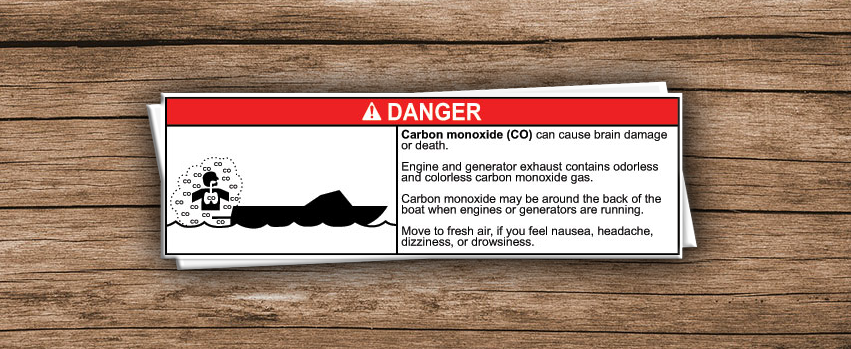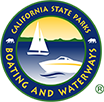
Exhaust from your boat’s engine or generator contains carbon monoxide, which can collect on or near your boat. Don’t let a boat outing turn deadly.
Carbon monoxide is an odorless, colorless gas that is present in the exhaust produced in gasoline engines. Boats release carbon monoxide through the exhaust ports of vessels that are either idling or underway and exhaust from generator sets. When inhaled, carbon monoxide replaces oxygen in tissues.
Symptoms of carbon monoxide poisoning may include nausea, dizziness, confusion, headache and fainting; however, people often mistakenly attribute these symptoms to too much alcohol, sun, and noise, or to motion sickness from the water or exhaustion. Exposure to carbon monoxide in large amounts or for a long duration results in death.
Traditionally, carbon monoxide poisonings have occurred on houseboats, vessels with overhead canopies or other vessels that have poor ventilation. Carbon monoxide also accumulates onboard a vessel through a process known as the ‘station wagon effect.’ This occurs as air moves around a boat and forms a low pressure area immediately behind the broad, flat transom. Carbon monoxide from the exhaust system enters the low-pressure area and is fed back into the cockpit and into cabin.
Many recent cases of carbon monoxide inhalation have involved a recreational activity known as ‘teak surfing’. ‘Teak surfing’ involves holding onto the swim platform or transom of an underway vessel to bodysurf on the wake of the vessel. As of January 1, 2005 , ‘teak surfing’ and other similar recreational activities are against the law in California.
Many recent cases of carbon monoxide inhalation have involved a recreational activity known as ‘teak surfing’. ‘Teak surfing’ involves holding onto the swim platform or transom of an underway vessel to bodysurf on the wake of the vessel. As of January 1, 2005 , ‘teak surfing’ and other similar recreational activities are against the law in California.
Assembly Bill 2222 (Koretz) requires that a set of carbon monoxide warning stickers be placed on the transom and helm of all new and used motorized vessels sold in California on or after May 1, 2005.
DBW has coordinated with nationwide boating interests to develop a set of universal carbon monoxide decals. The Department of Motor Vehicles will send the decals and an informational brochure out with all vessel registrations for the next four years. Boat manufacturers and dealers should order decals from the National Marine Manufacturers Association (NMMA). Decals will also be available to order online from the DBW Website. Scroll down to the “Other” section of the publications list and look for “Carbon Monoxide Danger.” DBW provides the decal and brochures as a set.
DBW has coordinated with nationwide boating interests to develop a set of universal carbon monoxide decals. The Department of Motor Vehicles will send the decals and an informational brochure out with all vessel registrations for the next four years. Boat manufacturers and dealers should order decals from the National Marine Manufacturers Association (NMMA). Decals will also be available to order online from the DBW Website. Scroll down to the “Other” section of the publications list and look for “Carbon Monoxide Danger.” DBW provides the decal and brochures as a set.
The dangers of carbon monoxide around boats cannot be understated. Nationwide, there were 571 reported boating-related carbon monoxide poisonings, including 113 deaths, between 1990 and 2004. Forty-three of the poisonings occurred in California. Because the carbon monoxide poisoning is only recently receiving attention, it is likely that many other deaths have been attributed to drowning or heart attack in years past may have been caused by carbon monoxide poisoning.
There are many ways to protect your family from the dangers of carbon monoxide. Several of the different precautions a boater can take are listed below.
Use a Marine Carbon Monoxide Detector – These detectors work much like smoke alarms in houses. They sense a moderate level of carbon monoxide present on the vessel and emit a loud siren noise to alert the occupants of the danger.
Ensure Proper Ventilation – Open foredeck hatches and a window in the cabin to allow fresh air to travel through the vessel. Also, be aware that carbon monoxide can collect under a canopy.
Inspect Exhaust System Regularly - Look and listen for leaks in the exhaust system. Check each joint for discoloration, water leaks, carbon build-up or stains. Make sure all ventilation systems are in good repair and are not obstructed, restricted, or punctured. Seal gaps around engine room and exhaust system doors, hatches, and access panels.
Avoid the Transom – The transom is where carbon monoxide collects. Stay away from the transom while the vessel is idling or underway.
Educate Children – Instruct your children about the danger and presence of carbon monoxide on vessels.
Avoid Other Idling Vessels – Idling vessels are a very prominent source for high concentrations of carbon monoxide. .
Use a Marine Carbon Monoxide Detector – These detectors work much like smoke alarms in houses. They sense a moderate level of carbon monoxide present on the vessel and emit a loud siren noise to alert the occupants of the danger.
Ensure Proper Ventilation – Open foredeck hatches and a window in the cabin to allow fresh air to travel through the vessel. Also, be aware that carbon monoxide can collect under a canopy.
Inspect Exhaust System Regularly - Look and listen for leaks in the exhaust system. Check each joint for discoloration, water leaks, carbon build-up or stains. Make sure all ventilation systems are in good repair and are not obstructed, restricted, or punctured. Seal gaps around engine room and exhaust system doors, hatches, and access panels.
Avoid the Transom – The transom is where carbon monoxide collects. Stay away from the transom while the vessel is idling or underway.
Educate Children – Instruct your children about the danger and presence of carbon monoxide on vessels.
Avoid Other Idling Vessels – Idling vessels are a very prominent source for high concentrations of carbon monoxide. .
Several other changes also went into effect January 1, 2005:
The motorboat noise level laws became applicable to coastal waters out to one mile from the shore instead of just inland waterways.
The motorboat noise level laws became applicable to state registered recreational vessels and federally documented vessels used for recreational purposes, which were previously exempt from motorboat noise laws.
The boat owner became responsible for the boat’s noise level instead of the operator who may have borrowed or rented the boat because the owner is responsible for basic maintenance and operability of the vessel.
The motorboat noise level laws became applicable to coastal waters out to one mile from the shore instead of just inland waterways.
The motorboat noise level laws became applicable to state registered recreational vessels and federally documented vessels used for recreational purposes, which were previously exempt from motorboat noise laws.
The boat owner became responsible for the boat’s noise level instead of the operator who may have borrowed or rented the boat because the owner is responsible for basic maintenance and operability of the vessel.
To learn more about the dangers of carbon monoxide, view our brochure online.
For a copy of the pamphlet and a carbon monoxide warning decal for your boat, order online, call (888) 326-2822 or write to Division of Boating and Waterway: One Capitol Mall, Suite 410 , Sacramento , CA 95814.
For a copy of the pamphlet and a carbon monoxide warning decal for your boat, order online, call (888) 326-2822 or write to Division of Boating and Waterway: One Capitol Mall, Suite 410 , Sacramento , CA 95814.
